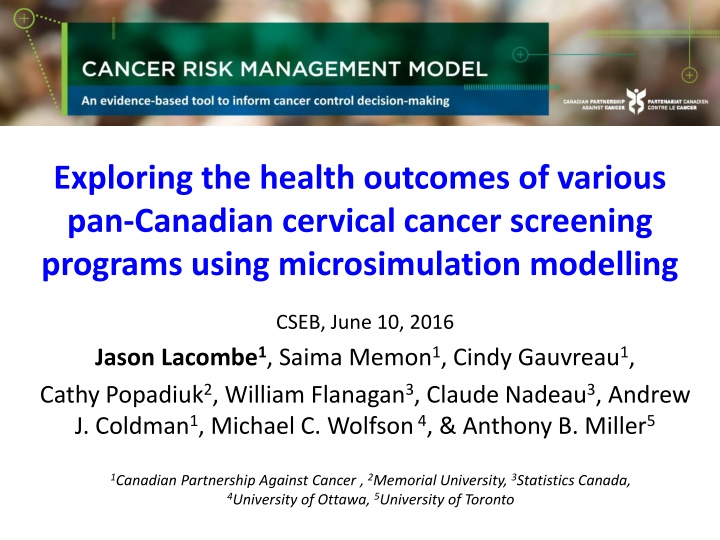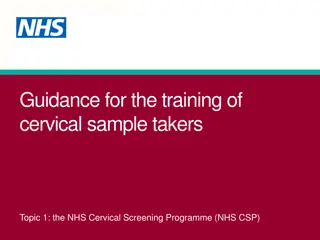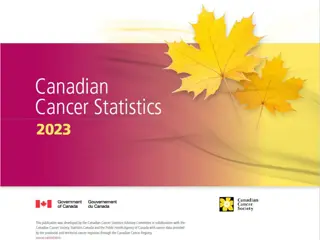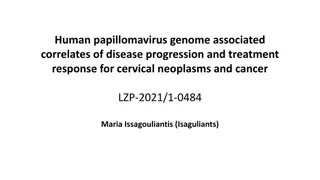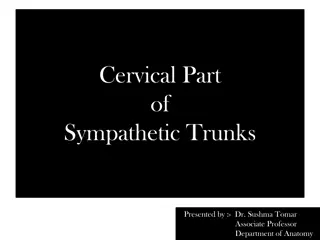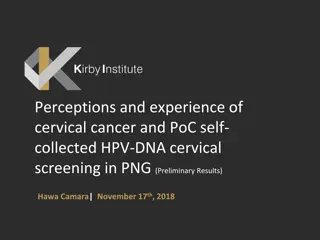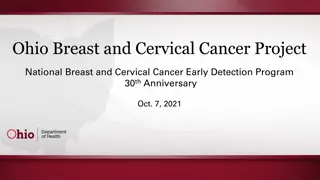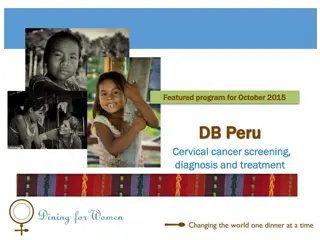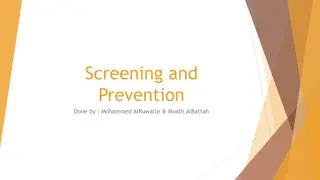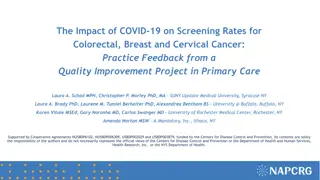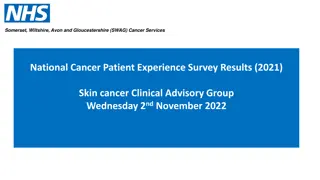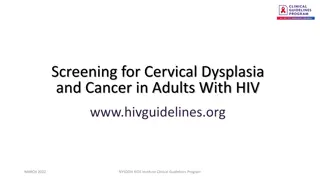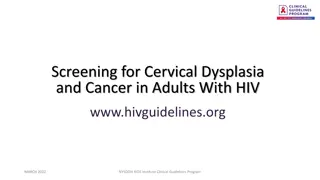Exploring the health outcomes of various pan-Canadian cervical cancer screening Programs using microsimulation modelling
This study evaluates the impact of Pap, HPV DNA, and combined testing on cervical cancer outcomes in Canada. The research aims to inform cancer control policies and decision-making by assessing various screening strategies.
Uploaded on Feb 28, 2025 | 1 Views
Download Presentation

Please find below an Image/Link to download the presentation.
The content on the website is provided AS IS for your information and personal use only. It may not be sold, licensed, or shared on other websites without obtaining consent from the author.If you encounter any issues during the download, it is possible that the publisher has removed the file from their server.
You are allowed to download the files provided on this website for personal or commercial use, subject to the condition that they are used lawfully. All files are the property of their respective owners.
The content on the website is provided AS IS for your information and personal use only. It may not be sold, licensed, or shared on other websites without obtaining consent from the author.
E N D
Presentation Transcript
Exploring the health outcomes of various pan-Canadian cervical cancer screening programs using microsimulation modelling CSEB, June 10, 2016 Jason Lacombe1, Saima Memon1, Cindy Gauvreau1, Cathy Popadiuk2, William Flanagan3, Claude Nadeau3, Andrew J. Coldman1, Michael C. Wolfson4, & Anthony B. Miller5 1Canadian Partnership Against Cancer , 2Memorial University, 3Statistics Canada, 4University of Ottawa, 5University of Toronto
Cervical Cancer Prevention and Early Detection ASIR: 7/100,000* ASMR: 1.6/100,000* >90% of all cervical cancers linked to persistent HPV infection Preventable through vaccination against HPV Prognosis is good if caught early using any of these screening strategies: o Pap Smear: conventional test that detects abnormal cells but requires follow-up colposcopy to confirm presence of cervical cancer o HPV DNA Test: more precise test that detects the presence of HPV infection but requires follow-up colposcopy to confirm presence of cervical cancer Colposcopy: invasive test to confirm presence of cervical cancer; exerts excessive burden on health care resources and patients * Canadian Cancer Society Statistics, 2015 2
Why Model HPV & Cervical Quickly quantify burden of cervical cancer on a population Review the effectiveness and/or efficiency of different screening protocols at the population level Provide evidence to inform policies about population level interventions 3
Objectives Evaluate the clinical impact of Pap, HPV DNA, and sequential Pap-HPV DNA testing in the Canadian context using the CRMM (version 2.2) Help inform cancer control policy and decision-making in Canada 4
HPV/Cervical Cancer Model: Conceptual Framework HPVMM CRMM (Cervical cancer) Incidence & Staging Progression of cancer HPV Sexual network & Virus transmission Natural history Case-fatality incidence Screening Treatment of cancer Vaccination Treatment of non-cancerous lesions Cervical cancer screening & treatment strategy Vaccine program strategy t5
Pertinent Modelling Assumptions Screening o Screening recruitment starts 2016 o Model simulates historical screening behaviour and allows one to design hypothetical future screening programs Vaccination o Vaccination rate 70% o Vaccine 100% effective o Girls vaccinated at age 12 6
Screening Variables Descriptor Variable Modalities* Pap only: every 3 years, from ages 21 or 25 until age 65 HPV DNA only: every 5 years, from ages 30 to 65 Aged-based sequential (ABS): both used sequentially, Pap every 3 years starting at 21 or 25 until 30, then HPV DNA every 5 years until age 65 Participation Effective participation rate was 72% of eligible population. *Reference scenario: Triennial Pap from age 25 to 65 years (CTFPHC) 7
Incidence of Cervical Cancer, 5-year Average Around 2046 1,440 1,435 Number of cervical cancer cases 1,430 1,425 1,420 1,415 1,410 1,405 1,400 1,395 ABS, 21 x 3; 30 x 5 ABS, 25 x 3; 30 x 5 Pap, 21 x 3 Pap, 25 x 3 HPV, 30 x 5 8
Mortality of Cervical Cancer, 5-year Average Around 2046 505 Number of cervical cancer deaths 500 495 490 485 480 475 470 ABS, 21 x 3; 30 x 5 ABS, 25 x 3; 30 x 5 Pap, 21 x 3 Pap, 25 x 3 HPV, 30 x 5 9
Number of Cervical Cancer Screens, 5-year Average Around 2046 3.5 3.0 Number of screens HPV DNA Test Count 2.5 (Millions) 2.0 1.5 Primary Cytology Count 1.0 0.5 0.0 Pap, 21 x 3 Pap, 25 x 3 HPV, 30 x 3 ABS, 21 x 3; ABS, 25 x 3; 30 x 5 30 x 5 10
Number of Colposcopies, 5-year Average Around 2046 180 160 Number of colposcopies 140 (Thousands) 120 100 80 60 40 20 0 Pap, 21 x 3 Pap, 25 x 3 ABS, 21 x 3; ABS, 25 x 3; 30 x 5 HPV, 30 x 5 30 x 5 11
Difference of Outcomes Compared to Reference Scenario Scenario Difference in incidence (% change) Difference in mortality (% change) Difference in colposcopies (% change) Difference in screens (% change) Pap, 25 x 3 - Referencea n/a n/a n/a n/a Pap, 21 x 3 -10 (1) -3 (1) 15,000 (10) 163,000 (6) HPV, 30 x 5 1 (0) -3 (1) -82,000 (55) -1,195,000 (43) ABS, 21 x 3; 30 x 5 -24 (2) -13 (3) -45,000 (30) -771,000 (28) ABS, 25 x 3; 30 x 5 -16 (1) -11 (2) -61,000 (41) -927,000 (33) a Values for the reference scenario: incident cases = 1440; deaths = 500; colposcopies = 149,680; screens = 2,800,790. * All figures in table are rounded and based on 5-year average around 2046. 12
Discussion Women < 30 years could have high rates of transient HPV infection and cervical abnormalities, most of which resolve on their own, but once detected could trigger largely unnecessary colposcopies and diagnostic tests A switch to HPV DNA screening or ABS screening could result in substantially fewer screens and colposcopies compared to Pap testing over the next 30 years In the Canadian context, a shift from Pap testing to HPV DNA testing or ABS screening could result in significant cost savings without negatively impacting incidence or mortality 13
Limitations The Ontario follow-up protocol for HPV DNA test as the primary screening modality was used, which may impact screening outcomes (i.e. number of colposcopies) HPV DNA testing comes with some uncertainty related to performance and cost in the Canadian context as it has not yet been widely implemented Due to little empirical data on sexual behaviour, long-term data on vaccine efficacy and questions around the development and progression of lesions and HPV-related cancers, there is a high degree of uncertainty in this parameter Due to very low prevalence of cervical cancer, estimates are subject to a high degree of Monte Carlo uncertainty 14
Conclusions According to the CRMM, changing from Pap to HPV DNA testing only, or age- based sequential screening, would be a better strategy for cervical cancer screening in Canada with respect to impact on incidence, mortality, and screening/diagnostic test volumes. Implications include: o Potential economic savings o Reduced psychological burden o Improved patient experience 15
Thank you! Questions? The CRMM is made possible by a financial contribution from Health Canada through the Canadian Partnership Against Cancer Special thank you to members of the Cervical Cancer Working Group 16
Contact us to learn more! Email: riskmgmt@cancerview.ca Web: www.cancerview.ca/cancerriskmanagement 17
CRMM Publications (10) FOUNDATIONAL Evans WK, Wolfson MC, Flanagan WM, et al. Canadian Cancer Risk Management Model: Evaluation of cancer control. Int J Technol Assess Health Care. 2013 Apr; 29(2):131-9. LUNG CANCER Evans WK, Wolfson M, Flanagan WM, et al. The evaluation of cancer control intervention in lung cancer using the Canadian Cancer Risk Management Model. Lung Cancer Manage. 2012; 1(1):25-33. Louie AV, Rodrigues GB, Palma DA, et al. Measuring the population impact of introducing stereotactic ablative radiotherapy for stage I non-small cell lung cancer in Canada. Oncologist. 2014 Aug; 19(8):880-5. Fitzgerald NR, Flanagan WM, Evans WK, et al. Eligibility for low-dose computerized tomography screening among asbestos-exposed individuals. Scand J Work Environ Health. 2015 Apr. Flanagan WM, Evans WK, Fitzgerald NR, et al. Performance of the Cancer Risk Management Model lung cancer screening module. Health Reports. 2015 May; 26(5). Goffin JR, Flanagan WM, Miller AB et al. The Cost-Effectiveness of Lung Cancer Screening in Canada. JAMA Oncology; 2015;1(6):807-813 Evans WK, Flanagan WM, Miller AB, et al. Implementing Low Dose CT Screening for Lung Cancer in Canada: Implications of Alternative At Risk Populations, Screening Frequency and Duration. Accepted for publication to Current Oncology COLORECTAL CANCER Coldman AJ, Phillips N, Brisson J, et al. Evaluating colorectal cancer screening options for Canada using the Cancer Risk Management Model. 2015 Apr; 22(2):e41-50. CERVICAL CANCER / HPV 18 Miller AB, Gribble S, Nadeau C et al. Evaluation of the Natural History of cancer of the cervix, implications for prevention. The Cancer Risk Management Model (CRMM)- Human PapillomaVirus and Cervical components. Journal of Cancer Policy 4 (2015) 1 6. Popadiuk C, BhavsarM, Wolfson MC, et al. Evaluating the health and economic impact of cytology versus primary HPV DNA cervical cancer screening in Canada using the Cancer Risk Management Model (CRMM). Curr Oncol. 2016 Feb; 23(Suppl 1): S56 S63.
www.cancerview.ca/cancerriskmanagement Request an account Training and Support Model Login 19
Main Data Sources Data Type Source Mortality, Birth, Population projections Vital Statistics (1950-2005), Census (2006, 2011) Incidence, Staging, (Survival) Canadian Cancer Registry (1992-2010) Cancer Survival by stage British Columbia Cancer Registry Data (1992-2012) Chart review (1991-92), Literature (1981, 1990-2000, 2005), Smoking rates Canadian Community Health Survey (2000-2007), National Population Health Survey (1994-2004) Canadian Health Survey (1979) Time use data General Social Survey (2005) Earnings, Transfers, and Taxes Census 2006, SPSD/M v16.1 (2005) Total health care expenditures Canadian Institute for Health Information (2006) Health care costs: diagnosis, treatment, follow-up, palliative and terminal care Ontario Case Costing Initiative (2007-2008), Provincial formulary (2009), Provincial Ministries of Health (2009) Current treatment practice Expert Opinion, Ontario admin data Screening, Lung cancer risk equation, Radon exposure, sexual network, HPV virus transmission Canadian Breast Cancer Screening Database, British Columbia admin data, CCHS, Reports, Literature Health status Classification and Measurement System, CCHS 20
Model Assessment Consultation (external) Face Validity Current practice/costs reviewed by experts from across Canada not involved in building model Case study evaluations Inspect simulated individual life trajectories for plausibility Internal validation External validation Ensure model outputs are consistent with model inputs Ensure model outputs are consistent with other data sources not used to build model Example: Example: Do incidence rates generate the expected number of cancer cases? Can we replicate outcomes from other studies (RCTs)? Calibration ( model fitting ) An iterative process of parameter estimation to ensure that the underlying model processes can match a pre-selected set of target data 21
